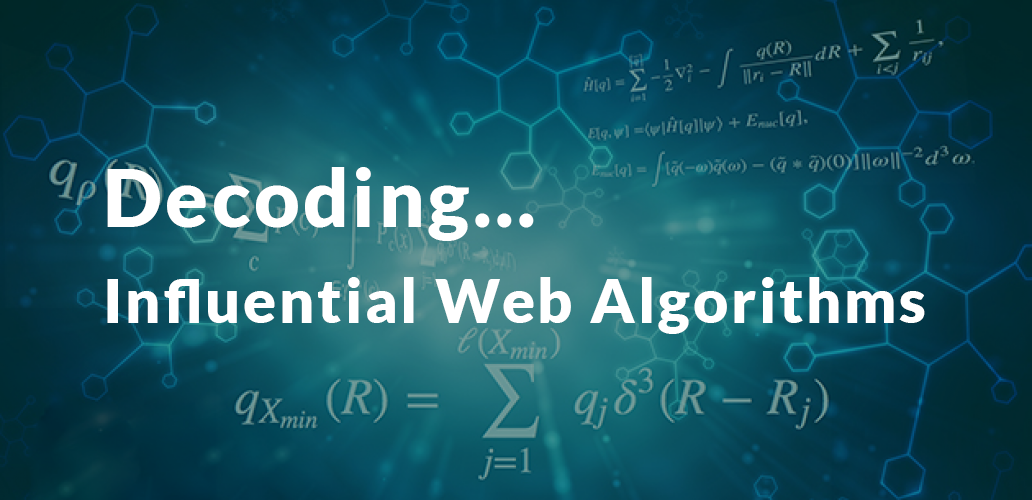Ultimate Guide to Decoding the Influential Web Algorithms
February 3, 2021 #digital-marketing
Earlier in the 20th century, life was simpler and harder at the same time. We weren’t aware of what else we might want to purchase on Amazon. We were not aware of the most important news/stories of the day. Before the invention of a movie recommendation engine, we had no mechanized assistance to determine which DVD to buy next. Google helps us to think, while Facebook helps us find friends. So, the influential web algorithms that these services embed are actually easing our problems and making our lives stress free.
Also, influential web algorithms do have a huge impact on our unique tastes, buying habits, and decisions regarding our digital lives. When we’re looking for something online, Google’s algorithm is right there to solve our issue of sorting and searching through a number of not very relevant results. On the contrary, these influential web algorithms might trap us in a world where brands and businesses couple behavioral data with website formulas to predict and manipulate what we decide next.
The technical trend towards the more influential web algorithms isn’t confined to situations where consumers seek information about products/services. Businesses are harnessing the power of these web algorithms to boost their efficiency in dealing with inventory control and their efficiency in monitoring behavior. They can also predict what their customer’s next move might be.
Interestingly, the internet is a Candyland of data to model & predict behavior with. Tracking IP addresses across the Net, analyzing what kind of websites people visit and when they visit these websites, counting on clicks – all are much easier with the implementation of influential web algorithms.
Here is a look at some of the amazing influential web algorithms and the interesting ways in which they work:
1. YouTube Up Next

These are a personalized list of videos that a viewer may have an interest in watching next, depending on their previous YouTube activities. These videos appear on the side panel of the YouTube interface or as ‘Watch Next’ if Autoplay is on. One user will not have the same experience as the other on YouTube. However, YouTube aims to serve the most relevant, personalized recommendations to each of its viewers. To achieve this, YouTube first analyzes users viewing history and identifies hundreds of videos that might be relevant to them.
Then, these videos are ranked depending on how well each video engages users, how often each viewer watches videos from each channel or videos relevant to the same topic, and the number of times YouTube has already shown each video to users.
Also, users tend to watch more content when they receive recommendations from a variety of channels.
2. Facebook News Feed

The algorithm behind the Facebook news feed was a rank-based approach called the Edge Rank Algorithm. This algorithm determines the order of posts based on three parameters: Affinity Score, Edge Weight & Time Decay.
Currently, the news feed algorithm has undergone a revamp through a machine learning approach. The algorithm considers more than 10000 weights and focuses on posts that are predicted to promote “active engagement”. The term active engagement means that the algorithm predicts scores by assigning greater weight to parameters that make a post personal & worthy of conversation.
The four parts of this algorithm are as follows:
-
Inventory
This comprises of all lined up posts that are yet to be viewed by the end-user. These posts include promotional content, posts from pages followed, etc. A number of such posts must compete with one or the other post each day to be visible to the algorithmic arbiter. In the end, only a few of these make it up to the news feed of the user after they pass through the algorithm’s filter.
-
Signals
Signals are all about the content consideration. Each post is analyzed based on the available data such as:
- Number of likes, comments & shares
- Type of Post (video, images, textual)
- Time and Day of a post
- Blocked Content
- Time spent on post
- Top fifty interactions
- Video engagement
-
Predictions
The algorithm attempts to predict based on information available to determine what the users prefer to see on their feed, what they may hide, how probable are they to engage with it actively. If video content is seen to be receiving higher engagement over text content or pictures, such posts are predicted to be preferred by the user.
-
Scoring
The predicted posts along with the weights are used to arrive at a relevancy score. The posts are then ordered based on this score in descending order. These posts are then delivered in the determined sequence to the news feed.
The present News Feed Algorithm is thus titled as a “ranking to organize” approach.
3. Google Search Rankings

With the amount of information available on the web, finding what we require would be nearly impossible without some sorting through it. Google ranking algorithms are updated to do the sorting through billions of webpages in our search index. This is done to find the most relevant, useful information in a fraction of a second and present them before us helping us find what we were looking for.
These ranking systems are made up of a whole series of algorithms. Search algorithms consider many factors such as the words of our query, relevance, and usability of web pages, the expertise of sources, our location, and settings. The weight applied to each criterion varies depending on the nature of the query.
To ensure search algorithms satisfy high standards of relevance and quality, a rigorous process is in place that involves both live tests & thousands of trained external Search Quality Raters from around the world. These Quality Raters abide by strict guidelines that define the goals for Search algorithms and are available for anyone to see.
4. Instagram Feed

The Instagram algorithm helps to surface the best and the most relevant content to each user every-time they check their Instagram feed. The whole point of this algorithm is to serve you the posts that really matter to you.
Instagram offers posts, using Machine Learning, that it thinks users would like and interact with. It is dependent on the user’s historical usage: the type of posts they liked and interacted with in the past as well as on the owner of the post. Also, the six main factors that determine what you see in your Instagram feed are:
-
Interest
-
Timeliness
-
Relationship
-
Frequency
-
Following
-
Usage
5. Youtube Related

Before Youtube generates video recommendations for viewers, the system first determines a set of relevant videos that a user is likely to watch after viewing a seed video. For this, it uses a method called co-visitation/association rule mining to identify pairs of videos watched during a particular session. Then, a relativity score is calculated for these videos. The relevant videos association rules are then combined with a user’s activity on the site, such as videos watched and liked by the user, to create a seed set. Once this is done, the paths of related videos can be traced out from this seed set to generate recommendations.
Once a set of video recommendations have been generated, they are ranked according to certain signals, which can be put into three groups:
-
video quality
-
user-specific, and
-
diversification
User-specific signals boost videos that are similar to a viewer’s unique preferences. In order to increase diversity, videos containing varied content can be put in place of recommendation videos that are too similar to one another.
6. Instagram Explore

Instagram has been working hard to make the Explore page more personalized to each individual user.
When we view our Instagram Explore page, it looks different than what may show up on other’s explore page. Instagram Explore is a gateway to discover content. And, this gateway is specifically tailor-made to help us find new content relevant to what we would enjoy watching on Instagram.
The Instagram Explore algorithm is constantly observing and analyzing from individual human behaviors of what accounts you follow, what posts you like and comment on & what Instagram stories you love to watch. It then uses this data to create an Instagram Explore page with suggestions of similar content that you might like.
7. Twitter Feed

The primary domain of Twitter’s feed algorithm is the Top Tweets. Top Tweets are visible to you depending on accounts that you interact with, tweets that you engage with, and so on. The essential ranking signals used by the Twitter feed algorithm are:
-
Recency:
- How recent the tweet is.
-
Engagement:
- No. of retweets, clicks, favorites, and impressions a tweet received.
- A tweet’s audience engagement is relative to other tweets from the same account.
- How often people interact with the tweet’s author, through active engagements.
-
Rich Media:
- The type of content present in a tweet (image, video, GIF) – and even polls.
- The type of media users tends to engage with.
-
Other factors:
- Duration for which a user has been away from the site.
- No. of followers an account has.
8. Reddit Popular

Reddit always uses a story algorithm called as the Reddit hot ranking. With the Reddit hot ranking algorithm, the number of votes and link publishing time have the largest effect on the rank of a story.
Reddit implements a logarithm function in its algorithm. Thus, the first votes on a link are more valuable than the later votes on a link. As a link gets older, it’s ranking also will slowly plummet. However, it is also essential to get some initial traction on a submission to give it early visibility.
Reddit ranks a post by calculating the number of votes a link has and then subtracting points based on how old that link is. So, recent links generally rank higher than older links. This updates the front page as well as ensures that links with highest up-votes aren’t on the front page for weeks or months together.
9. Instagram Suggested Follows

The Instagram Suggested Follows algorithm is pretty basic because the suggestions are based on whom you have searched before. It implies that whose account shows up at the top of your suggestions list is someone you would have searched for a number of times. The Instagram suggestion algorithm isn’t solely based on how often you look for a specific account. Even after we delete search suggestions, it will use some similarities that it found before you deleted the Instagram search history to make those accounts reappear in other ways.
10. Google Discover

A summary of your page can be given as a card that will be shown to users in Google Discover. This would be a scrollable list of topics that users can browse on their mobile devices. Tapping a card will direct the users to a page that is the source of the Discover entry.
Discover displays a mix of content to users based on their interactions with content/products on Google that they choose to follow directly. Google Discover is not confined to what is published today. Rather, if a user finds the earlier content interesting, then Discover will show it.
Discover also features videos, sports, entertainment updates, stock prices, and much more. Google Discover is a hub of content pertaining to the user’s interests.
Therefore, each social media websites have their own unique set of technical elements, intricate logic & usage analytics. And, these elements sum up the algorithm that delivers content to its users.
These influential web algorithms are managed by dedicated teams of data scientists, content strategists, and others to surface content & updates on user’s news feeds and search results.



